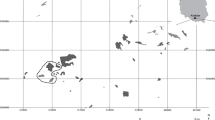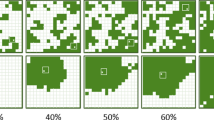Abstract
The spatial arrangement of resources in patchy habitats influences the distribution of individuals and their ability to acquire resources. We used Chironomus riparius, a ubiquitous aquatic insect that uses leaf particles as an important resource, to ask how the dispersion of resource patches influences the distribution and resource acquisition of mobile individuals in patchy landscapes. Two experiments were conducted in replicated laboratory landscapes (38×38 cm) created by arranging sand and leaf patches in a 5×5 grid so that the leaf patches were either aggregated or uniformly dispersed in the grid. One-day-old C. riparius larvae were introduced into the landscapes in one of three densities (low, medium, high). In experiment 1, we sampled larvae and pupae by coring each patch in each landscape 3, 6, 12, or 24 days after adding larvae. In experiment 2, emerging adults were collected daily for 42 days from each patch in each landscape. In aggregated landscapes, individuals were aggregated in one patch type or the other during a particular developmental stage, but the ”preferred” type changed depending on developmental stage and initial density. Adult emergence was lower by about 30% in all aggregated landscapes. In dispersed landscapes, individuals used both types of patch throughout their life cycles at all initial densities. Thus, patch arrangement influences the distribution of mobile individuals in landscapes, and it influences resource acquisition even when average resource abundance is identical among landscapes. Regardless of patch arrangement, high initial density caused accumulation of early instars in edge patches, 75% mortality of early instars, a 25% increase in development time, and a 60% reduction in adult emergence. Because mortality was extremely high among early-instar larvae in high-density treatments, we do not have direct evidence that the mechanism by which patch arrangement operates is density dependent. However, the results of our experiments strongly suggest that dispersion of resource patches across a landscape reduces local densities by making non-resource patches available for use, thereby reducing intraspecific competition.
Similar content being viewed by others
Author information
Authors and Affiliations
Additional information
Received: 20 July 1999 / Accepted: 28 January 2000
Rights and permissions
About this article
Cite this article
Silver, P., Cooper, J., Palmer, M. et al. The arrangement of resources in patchy landscapes: effects on distribution, survival, and resource acquisition of chironomids. Oecologia 124, 216–224 (2000). https://doi.org/10.1007/s004420050009
Issue Date:
DOI: https://doi.org/10.1007/s004420050009




